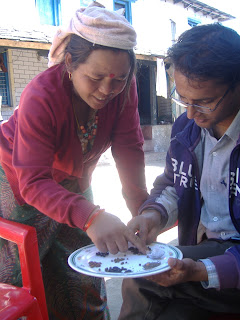I had a slightly unusual Christmas dinner this year – a delicious
feast of local fish, young jackfruit, forest leaves and rice.
We were in the remote Areng Valley in the Cardomon Mountains of Southern Cambodia. Getting there was an adventure in itself - a 2 hour pick up
from the main Koh Kong road and cycled 5 hours along rough tracks, towered over
by the lush old growth forests, until we popped out
into the flat fertile valley as the sun was setting.
The valley is home to over 1500 people in 9 villages, many
of which are indigenous Khmer Daeum (or ‘Old Khmer’), whose ancestors have been
living in the area for over 600 years [1].
Eating in villager’s homes almost all of the food was from
the valley and surrounding forest. New tastes in the form of wild harvested
leaves, fruits and herbs. Huko, a Village Elder explained how livelihoods
dependent on the abundant natural resources around them. Rice is grown in paddies around the villages, fruit and vegetables in forest gardens or Chamkar and leaves, fruits, roots (and
the occasional pig) are collected from the forest.
Down by the river we met Memy, the chief of Prolay village
who had gone down to fish as he and his fellow villagers do most days. Fishing
provides an important component of the diets of the Areng people.
The people we spoke to showed reverence to the forest and
the river for the lifesource it provided them. It provides them with daily
fresh, organic, nutritious food. They were very aware that without it they
would struggle to survive.
The forest also has spiritual significance for the people. Pok Luan (the best cook in the village!)
explained that in Daeum animist belief, ancestors and local deities are all
around them and villagers protect the sacred ‘spirit forests’ where they live.
This was evident walking through the forest - we came across these majestic
areas where thick old growth forest has been protected.
But all of this is could change.
The valley has been identified as the potential site for a
hydro-electric project – which although relatively small expected output
(100mW) is expected to flood 1500-2000 hectares, forcing the removal of people
from all 9 villages in the valley. The Stung Cheay Areng project would also
permit large-scale logging in the inundation zone and area surrounding. Although
two previous companies have withdrawn from the project, Chinese owned SinoHydro
is currently planning to take it forward with support from the Cambodian
Government.
Despite SinoHydros claimed Environmental
Policy Commitments, speaking to the
villagers they felt they had received very minimal information. But from what they understood the proposed resettlement
area is on a roadside in an area outside of the forest described as ‘rocky’!
The villagers fear that without access to the forest and
good farmland, they will not be able to produce enough food to eat and their
children will be forced to seek work elsewhere. Huko explained that;
“Here we can get all
that we need to live. If we move, it will be very hard, especially for new
generations who will not live the same way of life.”
The resettlement of the villagers will essentially create an
additional 1500 landless peasants – to add to the growing number in Cambodia[2].
This will clearly have huge implications for both their food security and future
way of life. Undermining their food sovereignty – that is their right to define
their own food systems.
We also spoke to the Forest Monks and Alejandro Gonzalez
Davidson who have founded the Mother Nature
Project. A Cambodian
grassroots movement fighting for the protection of the Cardamom forests and for
the preservation of the ancient culture and livelihoods of the local indigenous
communities. They explained how the project would also cause large-scale
habitat destruction through logging and flooding, with drastic impact on old
growth forest and local wildlife – including the rare Siamese Crocodile and a
host of other endemic species.
Mother Nature feel that the potential benefit of the dam –
in producing an estimated 100mW of power and the ‘trickle down’ economic
benefits for construction, materials, transmission lines and logging (amidst
widespread allegations of corruption within the Cambodian administration) – does not offset the huge irreversible impact
on the people and pristine ecology of the area.
In November,
Forest monks
walked into the valley to bless the trees and ordain them with robes in an effort
to protect them. The action of blessing trees is a tradition more common in
neighbouring Thailand but engaged by passionate Cambodian monks.
Mother Nature propose eco-tourism as an alternative – and through
the Wild KK project are starting to take small groups of tourists into the
valley. They propose that preserving the natural beauty of the valley will have
longer term economic benefits both for the local population and the Cambodian
tourist industry.
The local people are adamant that they won’t leave. Pok Luan
told us;
“I was born here, this
is my ancestors land.. I don’t want to leave.....We should save the land for
the next generation to live the same way of life. We are human beings, we just
want to live!”
I agree. By moving people out of the valley, the project will undermine the food sovereignty of the Areng people and take away a whole way of life. In a fast paced modern world I believe we need to work to protect these places and the right of people to feed themselves.
·
[1]
Summary of the Social and Environmental Impacts of the proposed Areng Valley
Hydro-Electric Dam, SouthWest Cambodia, www.rainforestinfo.org.au
[2] To set the context, since 2009 over 2 million hectares of Cambodias land has been sold to private companies by the Government – mainly as Economic Land Concessions.













